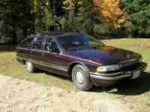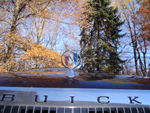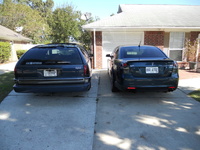|
| | Let's talk about car fires |  |
|
+795BRMW lakeffect Roadagon buickwagon Sprocket silverfox103 Mark 96 Roady 11 posters | | Author | Message |
|---|
Mark 96 Roady
Posts : 806
Join date : 2012-06-30
Age : 65
Location : Cleveland/Ft Myers Beach FL
 |  Subject: Let's talk about car fires Subject: Let's talk about car fires  Wed Oct 30, 2013 11:56 am Wed Oct 30, 2013 11:56 am | |
| In the wake of Joel's car fire, and out of deference to his request that we not clutter up his thread with any theories as to how it happened, I think a discussion of the matter is in order. I'll start, based on my experiences. As some of you may know, I am a retired insurance appraiser. I did it for about 25 years, so believe me I have seen plenty of car fires. I'll start with what I saw the most, to the least. Please keep in mind everything here I am about to state is based on what I actually saw on the job, not "what some guy told me". The most common car fire I saw was an underhood engine fire. Virtually every one I saw was a result of a greasy engine, combined with gasoline, of course, and some form of ignition. We are all driving these cars that are close to, or in some cases, 20 years old, and of course they start to leak over time. It looked to me like a lot of these fires were from leaky valve cover gaskets, and oil and sludge accumulated on the top of the engine, where, if a little gas leaked from the injectors, disaster was about to happen. Based on this experience, I always try to keep the top of my engine clean. The second most common car fire I saw was from improperly installed car audio, or some other improperly done electrical repair. Finally, the last type of fire was the one where no one knows what happened. I've seen fires in the rear package shelf, under the dash, inside doors, under the hood, you name it. Sometimes a component shorts, and gets hot enough to start a fire. Sometimes they peter out and the car can be saved, other times the whole car goes up. Obviously the last type of fire can't really be prevented, but the first two sure can. Keep the engine clean, don't do any obviously dangerous or stupid electrical repairs, and always carry comprehensive insurance. On old cars like ours, it can be as little (in my case) as $70 per year. So, to sum up; keep 'em clean under hood, no risky electrical repairs, and always carry comprehensive insurance!! | |
|   | | silverfox103
Moderator

Posts : 3371
Join date : 2008-11-05
Age : 75
Location : Littleton, NH & St. Simons, GA
 |  Subject: Re: Let's talk about car fires Subject: Re: Let's talk about car fires  Wed Oct 30, 2013 1:48 pm Wed Oct 30, 2013 1:48 pm | |
| Thanks Mark!
Your first two points, I do, keeping the engine clean and do quality electrical repairs (I worked as an electrician for almost 40 years). The third point, I have not done, carry comprehensive insurance. That will change tomorrow morning as I will be going to State Farm. These cars are old and tired, things are going to happen, it is cheap protection.
Thanks again for this informative post!
Tom | |
|   | | Sprocket

Posts : 6141
Join date : 2008-11-04
Location : Palm Beach County
 |  Subject: Re: Let's talk about car fires Subject: Re: Let's talk about car fires  Wed Oct 30, 2013 2:50 pm Wed Oct 30, 2013 2:50 pm | |
| In 2013, there have been two RMWs that burned up.
Joel's and Quiksilvers.
There is photos and video of Quik's on ISSF. In his case I believe it was to do with the headers burning something that caught and then to Mark's point above may have caught some sludge.
In Joel's case, I know the top of the motor was pretty clean. I've eyed under the hood of that car multiple times and it was well presented at shows. I do have to openly wonder though if it was somehow related to the electrical fire in the driver's door in that car about 2.5 years ago....
| |
|   | | silverfox103
Moderator

Posts : 3371
Join date : 2008-11-05
Age : 75
Location : Littleton, NH & St. Simons, GA
 |  Subject: Re: Let's talk about car fires Subject: Re: Let's talk about car fires  Wed Oct 30, 2013 3:20 pm Wed Oct 30, 2013 3:20 pm | |
| - Sprocket wrote:
- I do have to openly wonder though if it was somehow related to the electrical fire in the driver's door in that car about 2.5 years ago....
I agree, I don't think it's a coincidence. Tom | |
|   | | buickwagon

Posts : 958
Join date : 2011-06-10
Location : Muskoka, Ontario
 |  Subject: Re: Let's talk about car fires Subject: Re: Let's talk about car fires  Wed Oct 30, 2013 4:00 pm Wed Oct 30, 2013 4:00 pm | |
| Maybe some would benefit from some instruction on what constitutes "quality electrical repairs". The number 1 problem with aging electrical systems, IMHO, is probably corrosion at a connection. Corrosion = resistance. Not only does this cause bulbs to dim and motors to slow, if you pump current through a resistance you create heat, which of course can lead to a car fire. The second most common problem is probably short-circuits due to compromised insulation.
Personally, I prefer to strip a good inch of insulation from each end of a splice, slide 2" of double-wall weatherproof heat shield over one wire and twist them together lenthwise. By that I mean the wires are end-to-end, not side-by-side as I twist. This keeps the connection smooth and compact when I solder them together. The inner "wall" of double wall heat-shrink is similar to hot-melt glue. As the heat shrink collapses around the connection, the inner wall melts and oozes out the ends, sealing the connection more effectively than plain heat-shrink.
Of course, the wires are only half the story. Connectors are often the biggest problem, as they are harder to seal. Again, I like to solder the connector and cover the entire connection with double-wall HS. For the connection, I apply Kopr-Shield, a copper particle laden grease similar to anti-sieze, to the actual metal connection and dielectric (non-conductive) grease to any plastic insulation components. Both help keep the water away.
For existing connectors that are already suffering from corrosion, Deoxit D5 spray seems to be the best product (that I have found) for dissolving the corrosion. Sometimes a q-tip can help the process along. A toothpick can work a nice coating of Kopr-Shield into the connector afterwards.
Sometimes it's just not possible to tape or heatshrink an exposed electrical connection adequately. In this case, a couple of coats of Liquid Electrical Tape may be the only solution. You have to wait a little while between coats of this rubbery compound reminiscent of RTV. (BTW: If it starts going thick in the can, you can thin with lacquer thinner.)
Insulation can be compromised through heat, mechanical damage or even just old age. It is important that wires are routed properly, away from hot engine bits and pinch points. Sometimes a wire harness may be attached to another part, like a bracket, to keep it safely routed. It is important to replace those connectors if they are broken rather than just relying on memory effect to keep the wires in place. If a factory clip is unavailable and beyond redemption, a tie-wrap may suffice.
When running new wires for accessories like sound systems or trailer lights, plastic spiral split-loom is a good way to protect the insulation from damage. Carefully consider the routing and where the wire will bridge a moving part (eg: into a door from the post or into a seat from the floor) consider all the directions the wire may choose to go as the part moves.
Finally, and perhaps most importantly, use the right size wire for the current and protect it with the appropriate fuse as close as possible to the power source.
Anyone else have some good tips?
Last edited by buickwagon on Thu Oct 31, 2013 11:56 pm; edited 1 time in total (Reason for editing : corrected spelling of Kopr-Shield) | |
|   | | Roadagon
Posts : 139
Join date : 2011-12-23
 |  Subject: Re: Let's talk about car fires Subject: Re: Let's talk about car fires  Wed Oct 30, 2013 6:29 pm Wed Oct 30, 2013 6:29 pm | |
| I think this is all good stuff,we kind of have a beginners group ,learing fire prevention.
Keep the thoughts and ideas comming. ed | |
|   | | lakeffect

Posts : 3892
Join date : 2009-08-18
Location : Rochester NY 14621
 |  Subject: Re: Let's talk about car fires Subject: Re: Let's talk about car fires  Wed Oct 30, 2013 7:42 pm Wed Oct 30, 2013 7:42 pm | |
| Several Yeras back, I had an Under hood fire due to a defective component.
I was rtrying to set tghe base fuel pressure on my TPI system. I used a small Accel gauge that twirls onto the Schraeder valve on the injector manifold.
Open headers.
The pipe going into the back of the gauge was defective and sprayed a stream of fuel out.
Fuel + open headers = bad combination.
Luckily I keep an extinguisher just inside the garage door. It's literally the first thing you can grab past the door. I was able to put it out quickly.
Damage was limited to a few wires near the firewall connection and some convoluted tubing. I think the tubing saved a lot of the wiring.
Dave
| |
|   | | 95BRMW

Posts : 1695
Join date : 2009-08-15
Age : 40
Location : Connecticut
 |  Subject: Re: Let's talk about car fires Subject: Re: Let's talk about car fires  Thu Oct 31, 2013 8:26 am Thu Oct 31, 2013 8:26 am | |
| Another cause that non-auto climate control owners can see is caused by unwelcome guests in your car. Last year I had a fire in my 9C1 due to a mouse nest in the HVAC assembly. The nest was built around the blower motor and on top of the blower resistor, which is placed by the blower so it can cool because it gets so hot.
I started the car and took off in the morning not realizing the blower was set to full speed from the last time I drove it. It was somewhat warm out so I didn't think anything of it when I didn't hear the fan and didn't think to check it. The nest jammed the blower motor which caused it to draw more current trying to break free, which in turn heated the blower resistor even more which only a few seconds later ignited the nest. Luckily I was only a block away from home and while there was smoke pouring out of my dash I managed to get it back to my house and parked at the end of my driveway, all windows down. I was choking on the thick white smoke, but had to get to a hose.
Given the past of this car with shoddy electrical work by the PO I assumed something electrical shorted out. The smoke diminished so I started poking around under the dash to see what happened. As I'm digging around I noticed a flame behind the glove box. I grab the garden hose (no fire extinguisher around) break the glove box off and see a good size fire has melted through the hvac assembly. I flooded the underside of the dash, defroster vent and the cowl under the windshield for a good while and luckily put the fire out.
One thing to note, because the plastic had melted, I could not get to part of the HVAC assembly and had to bust the melted plastic out of the way to put out what was another fire about to happen.
While what I did saved the car, what I did was pretty dangerous. The whole bottom of the air bag was burnt, it probably would have gone off in my face as I was working there if the fire got any hotter. Also, I flooded the dash with water with the battery still hooked up. Somehow I did not blow any fuses from all this and the car ran an hour later.
I am a big fan of the cabin air filter mod because of this, i keeps the crap out of the HVAC and can prevent this from happening. I suppose if the blower sucked enough leaves in there the same thing can happen. I've seen a few Caprices on copart insurance auctions which cooked dashboards but nothing under the hood. I can only assume they fell victim to the same fate. | |
|   | | buickwagon

Posts : 958
Join date : 2011-06-10
Location : Muskoka, Ontario
 |  Subject: Re: Let's talk about car fires Subject: Re: Let's talk about car fires  Thu Oct 31, 2013 9:19 am Thu Oct 31, 2013 9:19 am | |
| | |
|   | | Roadagon
Posts : 139
Join date : 2011-12-23
 |  Subject: Re: Let's talk about car fires Subject: Re: Let's talk about car fires  Thu Oct 31, 2013 9:58 am Thu Oct 31, 2013 9:58 am | |
| The cabin filter looks good for cleaning the air inside the car,so from the standpoint
of cleaner air,a nice mod to do. I dont know how the filter would fare in a good rainstorm though.
If you were looking for something to stop mice,would a stiff piece of screen help to
prevent rodents from entering that area? ed | |
|   | | 95BRMW

Posts : 1695
Join date : 2009-08-15
Age : 40
Location : Connecticut
 |  Subject: Re: Let's talk about car fires Subject: Re: Let's talk about car fires  Thu Oct 31, 2013 10:19 am Thu Oct 31, 2013 10:19 am | |
| I was referring to the filter. On the Caprice I went a different route though. Being I had to replace the whole HVAC assembly I cut and riveted in a steel screen in the fresh air opening, which GM really should have put there in the first place. I bought a piece of gutter leaf guard and used that, it worked great. I don't even get leaves in there anymore. | |
|   | | mtrhead79

Posts : 1614
Join date : 2010-04-24
Age : 56
Location : phila. pa
 |  Subject: Re: Let's talk about car fires Subject: Re: Let's talk about car fires  Thu Oct 31, 2013 5:53 pm Thu Oct 31, 2013 5:53 pm | |
| quick silvers had just installed the front occ bumper i sold him what a shame | |
|   | | silverfox103
Moderator

Posts : 3371
Join date : 2008-11-05
Age : 75
Location : Littleton, NH & St. Simons, GA
 |  Subject: Re: Let's talk about car fires Subject: Re: Let's talk about car fires  Thu Oct 31, 2013 6:17 pm Thu Oct 31, 2013 6:17 pm | |
| If I remember correctly, I believe it was Mike 200OZ, who made brackets and installed the cabin filter. It worked great, until mice ate the filter and made a nest.
Tom | |
|   | | phantom 309

Posts : 5848
Join date : 2008-12-28
Age : 114
 |  Subject: Re: Let's talk about car fires Subject: Re: Let's talk about car fires  Thu Oct 31, 2013 8:58 pm Thu Oct 31, 2013 8:58 pm | |
| fire inside a car is not always a bad thing,..??  | |
|   | | buickwagon

Posts : 958
Join date : 2011-06-10
Location : Muskoka, Ontario
 |  Subject: Re: Let's talk about car fires Subject: Re: Let's talk about car fires  Fri Nov 01, 2013 7:20 pm Fri Nov 01, 2013 7:20 pm | |
| This would not have caused a fire, but in the spirit of documenting wiring faults:
My brake light came on today. The brakes were rock solid (fairly fresh lines). The parking brake was not on. I unplugged the connector on the brake pressure switch -- light was still on. I peeled back the bolster at the drivers footwell to check the parking brake switch, and discovered the wire was pinched between the parking brake mechanism and the firewall, right next to the mounting bolt. I kind of doubt it came that way from the factory, but I have not had the parking brake mechanism off during my ownership of this car, so the wire has been pinched for years and -- for no particular reason -- just picked today to finally break the insulation and short out. | |
|   | | Roadagon
Posts : 139
Join date : 2011-12-23
 |  Subject: Re: Let's talk about car fires Subject: Re: Let's talk about car fires  Sun Nov 03, 2013 8:01 am Sun Nov 03, 2013 8:01 am | |
| Does anyone know if there are specific type fire extinguishers that are more effective
on automobile fires than lets say the ones that people buy @ Home Depot or Wal-Mart?
ed | |
|   | | Krzdimond
Admin

Posts : 3412
Join date : 2008-11-04
Age : 57
Location : Savannah, GA
 |  Subject: Re: Let's talk about car fires Subject: Re: Let's talk about car fires  Sun Nov 03, 2013 8:34 am Sun Nov 03, 2013 8:34 am | |
| The Army uses 10 BC. extinguishers in their vehicles. A 20BC is just too big. On my phone now so I can't link the Google search. Check out the "purple K" and BC extinguishers. | |
|   | | buickwagon

Posts : 958
Join date : 2011-06-10
Location : Muskoka, Ontario
 |  Subject: Re: Let's talk about car fires Subject: Re: Let's talk about car fires  Sun Nov 03, 2013 4:45 pm Sun Nov 03, 2013 4:45 pm | |
| Short answer: 1st choice: a 5lb "ABC" type, rated 3A40BC. Second choice, a 2-1/2lb "ABC" rated 1A10BC.
Long answer: "BC" and "ABC" refers to the type of fire the extinguisher is effective on. A class "A" fire is an ordinary combustible (most solids), class "B" is a flammable liquid and class "C" is energized electrical equipment. (A 4th class, "D" refers to combustible metals, such as magnesium, and requires extinguishing agents specific to the metal.) Generally, if you remove the electricity from a class "C" fire, it becomes a class "A" fire.
"Purple K" is a class B extinguishing agent. More effective than other dry chemicals on pressurized gas fires, and better than ordinary dry chemical on liquid fires, it's not especially effective on Class "A" fires. Unless you have a propane-powered vehicle, the only pressurized gas commonly found is the AC refrigerant.
"BC" extinguishers usually discharge sodium bicarbonate (aka "ordinary dry chemical, white in colour) and "ABC" extinguishers contain monoammonium phosphate (yellow), both of which leave a somewhat corrosive residue. The "ABC" residue is particularly sticky. "Purple K" is mostly potasium bicarbonate (dyed purple), which leaves a distinctly corrosive residue.
Since it is unlikely that one will carry a selection of extinguishers in one's personal car, I recommend choosing an ABC type for it's versatility.
The numbers refer to the size of the fire that extinguisher can handle (theoretically, by trained personnel, under controlled laboratory conditions). The bigger the number, the bigger the fire it can handle. EG: a 3A40BC can handle a fire three times as big as a 1A10BC. A 5lb ordinary dry chemical (ie: sodium bicarbonate) extinguisher is usually rated about 10BC, a 5lb "Purple K", about 20BC and a 5lb monoammonium phosphate, about 3A30BC. So for the same size extinguisher, the ABC can handle a larger fire than either of the other two, as well as more kinds of fires. The downside is you have to be more diligent during clean-up compared to sodium bicarbonate, as it is more corrosive (but still less corrosive than Purple K).
While an extinguisher can be any shape, usually the 2-1/2lb and 5lb extinguishers are about the same length, but the bigger extinguisher is about twice the diameter and can handle 3 times the amount of fire.
One last note: any dry chemical extinguisher is subject to caking -- ie: the powder settles to the bottom and starts turning into sedimentary rock. Monthly, you should invert the extinguisher and whack the bottom with a rubber mallet a few times to keep the powder loose. At the same time, check the pressure gauge, and peek inside the nozzle to make sure a spider has not plugged it with an egg sack or something. | |
|   | | Roadagon
Posts : 139
Join date : 2011-12-23
 |  Subject: Re: Let's talk about car fires Subject: Re: Let's talk about car fires  Sun Nov 03, 2013 6:29 pm Sun Nov 03, 2013 6:29 pm | |
| Great info Mr. Buickwagon, ed | |
|   | | phantom 309

Posts : 5848
Join date : 2008-12-28
Age : 114
 |  Subject: Re: Let's talk about car fires Subject: Re: Let's talk about car fires  Sun Nov 03, 2013 10:05 pm Sun Nov 03, 2013 10:05 pm | |
| Well in all honesty, if any of my fleet were to catch fire,. i would rub my hands with glee,. step back make sure the key was left on,. and let it burn,.. preferably right down to a charred hulk,. it,s always easier to negotiate a value,. when there's nothing left to contradict,..  Nick | |
|   | | cadillac kevin
Posts : 269
Join date : 2011-06-09
Age : 33
 |  Subject: Re: Let's talk about car fires Subject: Re: Let's talk about car fires  Thu Nov 14, 2013 8:59 pm Thu Nov 14, 2013 8:59 pm | |
| I actually had a piece of the plastic spiral split loom catch fire on my header. When my mechanic did the engine swap in my car (to save me money), he simply cut back the wires and put them in the loom and ziptied it to the main harness on the firewall in many places (to make sure it didnt go anywhere until I got it home and could get around to cleaning up the harness). On the ride back home from the shop, I smelled something funny, so when I got home, I popped the hood. The last zip tie holding the wire had broken, letting the last couple inches of the loom fall onto the header. Thankfully, nothing caught fire, but the loom was melted (theres a glob of plastic stuck on my header from it). I have since cut back the wires, and routed them into the main loom, removing that branch of the harness. | |
|   | | Sponsored content
 |  Subject: Re: Let's talk about car fires Subject: Re: Let's talk about car fires  | |
| |
|   | | | | Let's talk about car fires |  |
|
Similar topics |  |
|
| | Permissions in this forum: | You cannot reply to topics in this forum
| |
| |
| |
